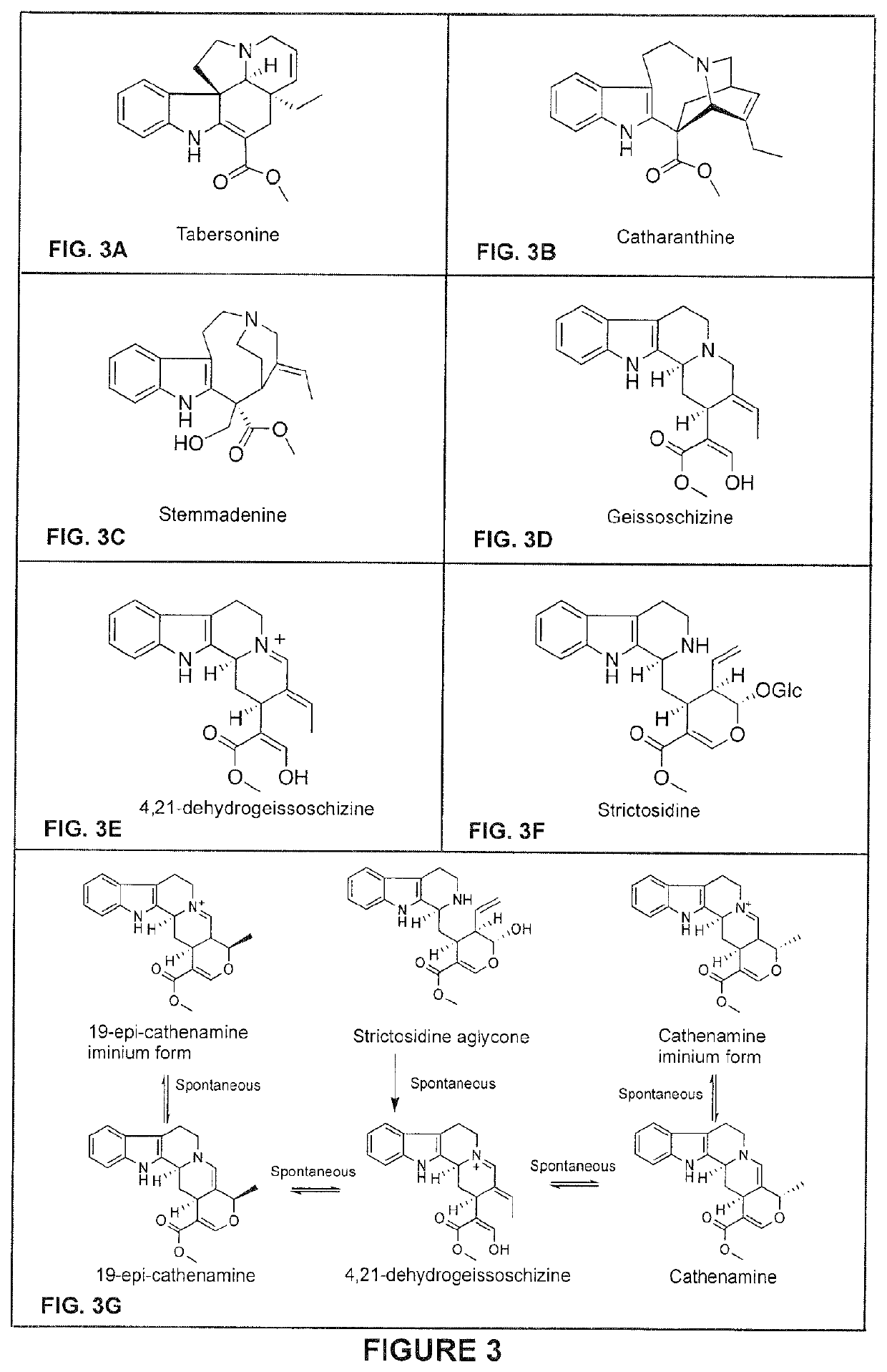Compositions and methods for making terpenoid indole alkaloids
a technology of terpenoid indole and alkaloids, which is applied in the field of terpenoid indole alkaloids, can solve the problems of inability to manufacture therapeutic quantities of vincristine and vinblastine on a commercial scale, the limitations of known methodologies, and the inability to meet the requirements of synthetic manufacturing techniques,
- Summary
- Abstract
- Description
- Claims
- Application Information
AI Technical Summary
Benefits of technology
Problems solved by technology
Method used
Image
Examples
example 1
Production of Geissoschizine
[0707]This example illustrates the in vitro production of geissoschizine using GS as a catalyzing enzyme. In vitro reactions (200 μl) containing 20 mM Tris pH 7.5, 1 mM NADPH, 5 μg strictosidine aglycone and 2.5 μg of recombinantly E. coli produced and purified GS were prepared. Reactions were set up to take place at 30° C. for 1 hr and the reaction products were dissolved in methanol and analyzed by LC-MS as selected ion chromatogram (SIC). As shown in FIG. 5, under the reaction conditions GS catalyzes the production of geissoschizine, as well as its isomer (m / z 353). In addition, tetrahydroalstonine is detected as a byproduct. It is noted however that in that in VIGS-GO plants only geissoschizine accumulates (see: Example 8).
example 2
Production of Monooxygenated Geissoschizine
[0708]This example illustrates the in vitro production of monooxygenated geissoschizine using GS and GO as a catalyzing enzymes. In vitro reactions (200 μl) containing 20 mM Tris pH 7.5, 1 mM NADPH, 5 μg strictosidine aglycone and 2.5 μg of each recombinantly produced and purified E. coli GS and 200 mg yeast microsome containing GO were prepared. Reactions were set up to take place at 30° C. for 1 hr and the reaction products were dissolved in methanol and analyzed by LC-MS as selected ion chromatogram (SIC). As shown in FIG. 6, under the reaction conditions the GS and GO enzyme mixture catalyzes the production of monooxygenated geissoschizine. It is noted that monooxygenated geissoschizine also accumulate in VIGS-REDOX 1 plants (see: Example 9)
example 3
Production of Isositsirikine
[0709]This example illustrates the in vitro production of isositsirikine using GS and REDOX 2 as catalyzing enzymes. In vitro reactions (200 μl) containing 20 mM Tris pH 7.5, 1 mM NADPH, 5 μg strictosidine aglycone and 2.5 μg of each recombinantly E. coli produced and purified GS and REDOX 2 were prepared. Reactions were set up to take place at 30° C. for 1 hr and the reaction products were dissolved in methanol and analyzed by LC-MS as selected ion chromatogram (SIC). As shown in FIG. 7, under the reaction conditions the GS and REDOX 2 enzyme mixture catalyzes the production of two isomeric forms of isositsirikine. It is noted that isositsirikine also accumulate in VIGS-GO plants (see: Example 8).
PUM
| Property | Measurement | Unit |
|---|---|---|
| temperature | aaaaa | aaaaa |
| Tm | aaaaa | aaaaa |
| temperatures | aaaaa | aaaaa |
Abstract
Description
Claims
Application Information
 Login to View More
Login to View More - Generate Ideas
- Intellectual Property
- Life Sciences
- Materials
- Tech Scout
- Unparalleled Data Quality
- Higher Quality Content
- 60% Fewer Hallucinations
Browse by: Latest US Patents, China's latest patents, Technical Efficacy Thesaurus, Application Domain, Technology Topic, Popular Technical Reports.
© 2025 PatSnap. All rights reserved.Legal|Privacy policy|Modern Slavery Act Transparency Statement|Sitemap|About US| Contact US: help@patsnap.com



